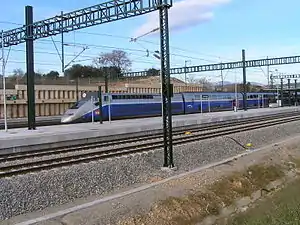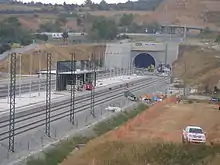Perpignan–Barcelona high-speed rail line
The Perpignan–Barcelona high-speed line is an international high-speed rail line between France and Spain. The line consists of a 175.5-kilometre (109.1 mi) railway, of which 24.6 km are in France and 150.8 km are in Spain. It crosses the French–Spanish border via the 8.3-kilometre (5.2 mi) Perthus Tunnel bored under the Perthus Pass,[1] connecting two small cities on opposite sides of the border, Perpignan in Roussillon, France, and Figueres in Catalonia, Spain. The line extends to Barcelona, and this part is sometimes referenced as an extension of the Madrid–Barcelona high-speed rail line. The Perpignan–Barcelona line is a part of the Mediterranean Corridor.[2][3]
| Perpignan–Barcelona high-speed rail line | ||||||||||||||||||||||||||||||||||||||||||||||||||||||||||||||||||||||||||||||||||||||||||||||||||||||||||||||||||||||||||||||||||||||||||||||||||||||||||||||||||||||||||||||||||||||||||||||||||||||||||||||||||||||||||||||||||||||||||||||||||||||||||||||||||||||||||
|---|---|---|---|---|---|---|---|---|---|---|---|---|---|---|---|---|---|---|---|---|---|---|---|---|---|---|---|---|---|---|---|---|---|---|---|---|---|---|---|---|---|---|---|---|---|---|---|---|---|---|---|---|---|---|---|---|---|---|---|---|---|---|---|---|---|---|---|---|---|---|---|---|---|---|---|---|---|---|---|---|---|---|---|---|---|---|---|---|---|---|---|---|---|---|---|---|---|---|---|---|---|---|---|---|---|---|---|---|---|---|---|---|---|---|---|---|---|---|---|---|---|---|---|---|---|---|---|---|---|---|---|---|---|---|---|---|---|---|---|---|---|---|---|---|---|---|---|---|---|---|---|---|---|---|---|---|---|---|---|---|---|---|---|---|---|---|---|---|---|---|---|---|---|---|---|---|---|---|---|---|---|---|---|---|---|---|---|---|---|---|---|---|---|---|---|---|---|---|---|---|---|---|---|---|---|---|---|---|---|---|---|---|---|---|---|---|---|---|---|---|---|---|---|---|---|---|---|---|---|---|---|---|---|---|---|---|---|---|---|---|---|---|---|---|---|---|---|---|---|---|---|---|---|---|---|---|---|---|---|---|---|---|---|---|---|---|
 Figueres–Vilafant railway station: first TGV arrival from Paris, December 2010 | ||||||||||||||||||||||||||||||||||||||||||||||||||||||||||||||||||||||||||||||||||||||||||||||||||||||||||||||||||||||||||||||||||||||||||||||||||||||||||||||||||||||||||||||||||||||||||||||||||||||||||||||||||||||||||||||||||||||||||||||||||||||||||||||||||||||||||
| Overview | ||||||||||||||||||||||||||||||||||||||||||||||||||||||||||||||||||||||||||||||||||||||||||||||||||||||||||||||||||||||||||||||||||||||||||||||||||||||||||||||||||||||||||||||||||||||||||||||||||||||||||||||||||||||||||||||||||||||||||||||||||||||||||||||||||||||||||
| Status | Operational | |||||||||||||||||||||||||||||||||||||||||||||||||||||||||||||||||||||||||||||||||||||||||||||||||||||||||||||||||||||||||||||||||||||||||||||||||||||||||||||||||||||||||||||||||||||||||||||||||||||||||||||||||||||||||||||||||||||||||||||||||||||||||||||||||||||||||
| Owner | SNCF Réseau (French side), Adif (Spanish side) | |||||||||||||||||||||||||||||||||||||||||||||||||||||||||||||||||||||||||||||||||||||||||||||||||||||||||||||||||||||||||||||||||||||||||||||||||||||||||||||||||||||||||||||||||||||||||||||||||||||||||||||||||||||||||||||||||||||||||||||||||||||||||||||||||||||||||
| Locale | France (Languedoc-Roussillon), Spain (Catalonia) | |||||||||||||||||||||||||||||||||||||||||||||||||||||||||||||||||||||||||||||||||||||||||||||||||||||||||||||||||||||||||||||||||||||||||||||||||||||||||||||||||||||||||||||||||||||||||||||||||||||||||||||||||||||||||||||||||||||||||||||||||||||||||||||||||||||||||
| Termini | Gare de Perpignan Barcelona Sants railway station | |||||||||||||||||||||||||||||||||||||||||||||||||||||||||||||||||||||||||||||||||||||||||||||||||||||||||||||||||||||||||||||||||||||||||||||||||||||||||||||||||||||||||||||||||||||||||||||||||||||||||||||||||||||||||||||||||||||||||||||||||||||||||||||||||||||||||
| Service | ||||||||||||||||||||||||||||||||||||||||||||||||||||||||||||||||||||||||||||||||||||||||||||||||||||||||||||||||||||||||||||||||||||||||||||||||||||||||||||||||||||||||||||||||||||||||||||||||||||||||||||||||||||||||||||||||||||||||||||||||||||||||||||||||||||||||||
| Type | High-speed rail | |||||||||||||||||||||||||||||||||||||||||||||||||||||||||||||||||||||||||||||||||||||||||||||||||||||||||||||||||||||||||||||||||||||||||||||||||||||||||||||||||||||||||||||||||||||||||||||||||||||||||||||||||||||||||||||||||||||||||||||||||||||||||||||||||||||||||
| System | Mediterranean Corridor | |||||||||||||||||||||||||||||||||||||||||||||||||||||||||||||||||||||||||||||||||||||||||||||||||||||||||||||||||||||||||||||||||||||||||||||||||||||||||||||||||||||||||||||||||||||||||||||||||||||||||||||||||||||||||||||||||||||||||||||||||||||||||||||||||||||||||
| Operator(s) | SNCF, Renfe Operadora | |||||||||||||||||||||||||||||||||||||||||||||||||||||||||||||||||||||||||||||||||||||||||||||||||||||||||||||||||||||||||||||||||||||||||||||||||||||||||||||||||||||||||||||||||||||||||||||||||||||||||||||||||||||||||||||||||||||||||||||||||||||||||||||||||||||||||
| Rolling stock | SNCF TGV Duplex AVE Class 100 (from 2014) RENFE Class 252 (freight services) | |||||||||||||||||||||||||||||||||||||||||||||||||||||||||||||||||||||||||||||||||||||||||||||||||||||||||||||||||||||||||||||||||||||||||||||||||||||||||||||||||||||||||||||||||||||||||||||||||||||||||||||||||||||||||||||||||||||||||||||||||||||||||||||||||||||||||
| History | ||||||||||||||||||||||||||||||||||||||||||||||||||||||||||||||||||||||||||||||||||||||||||||||||||||||||||||||||||||||||||||||||||||||||||||||||||||||||||||||||||||||||||||||||||||||||||||||||||||||||||||||||||||||||||||||||||||||||||||||||||||||||||||||||||||||||||
| Opened | 2013 | |||||||||||||||||||||||||||||||||||||||||||||||||||||||||||||||||||||||||||||||||||||||||||||||||||||||||||||||||||||||||||||||||||||||||||||||||||||||||||||||||||||||||||||||||||||||||||||||||||||||||||||||||||||||||||||||||||||||||||||||||||||||||||||||||||||||||
| Technical | ||||||||||||||||||||||||||||||||||||||||||||||||||||||||||||||||||||||||||||||||||||||||||||||||||||||||||||||||||||||||||||||||||||||||||||||||||||||||||||||||||||||||||||||||||||||||||||||||||||||||||||||||||||||||||||||||||||||||||||||||||||||||||||||||||||||||||
| Line length | 175.5 km (109.1 mi) | |||||||||||||||||||||||||||||||||||||||||||||||||||||||||||||||||||||||||||||||||||||||||||||||||||||||||||||||||||||||||||||||||||||||||||||||||||||||||||||||||||||||||||||||||||||||||||||||||||||||||||||||||||||||||||||||||||||||||||||||||||||||||||||||||||||||||
| Number of tracks | Double track | |||||||||||||||||||||||||||||||||||||||||||||||||||||||||||||||||||||||||||||||||||||||||||||||||||||||||||||||||||||||||||||||||||||||||||||||||||||||||||||||||||||||||||||||||||||||||||||||||||||||||||||||||||||||||||||||||||||||||||||||||||||||||||||||||||||||||
| Track gauge | 1,435 mm (4 ft 8 1⁄2 in) standard gauge | |||||||||||||||||||||||||||||||||||||||||||||||||||||||||||||||||||||||||||||||||||||||||||||||||||||||||||||||||||||||||||||||||||||||||||||||||||||||||||||||||||||||||||||||||||||||||||||||||||||||||||||||||||||||||||||||||||||||||||||||||||||||||||||||||||||||||
| Electrification | 25 kV 50 Hz | |||||||||||||||||||||||||||||||||||||||||||||||||||||||||||||||||||||||||||||||||||||||||||||||||||||||||||||||||||||||||||||||||||||||||||||||||||||||||||||||||||||||||||||||||||||||||||||||||||||||||||||||||||||||||||||||||||||||||||||||||||||||||||||||||||||||||
| Operating speed | 320 km/h (200 mph) | |||||||||||||||||||||||||||||||||||||||||||||||||||||||||||||||||||||||||||||||||||||||||||||||||||||||||||||||||||||||||||||||||||||||||||||||||||||||||||||||||||||||||||||||||||||||||||||||||||||||||||||||||||||||||||||||||||||||||||||||||||||||||||||||||||||||||
| Signalling | ASFA and ERTMS | |||||||||||||||||||||||||||||||||||||||||||||||||||||||||||||||||||||||||||||||||||||||||||||||||||||||||||||||||||||||||||||||||||||||||||||||||||||||||||||||||||||||||||||||||||||||||||||||||||||||||||||||||||||||||||||||||||||||||||||||||||||||||||||||||||||||||
| ||||||||||||||||||||||||||||||||||||||||||||||||||||||||||||||||||||||||||||||||||||||||||||||||||||||||||||||||||||||||||||||||||||||||||||||||||||||||||||||||||||||||||||||||||||||||||||||||||||||||||||||||||||||||||||||||||||||||||||||||||||||||||||||||||||||||||


History
The construction contract for the international section of the line between Perpignan and Figueres was awarded on 17 February 2004 to the TP Ferro consortium, a joint venture of Eiffage (France) and Dragados (Spain).[1] The group constructed the line for an estimated cost of approximately €1.1 billion, and will operate it for 53 years.[4] It received a public subsidy of €540 million, split between the European Union, France and Spain.
Test running started in November 2008, and the international section officially opened on 17 February 2009, but services were delayed until December 2010 because the station at Figueres was not finished.[5][6][7] Services in the section started on 19 December 2010 with a TGV service from Paris via Perpignan to Figueres–Vilafant and regular freight traffic started on 21 December 2010. Eventually the 44.5-kilometre (27.7 mi) international section was officially inaugurated on 27 January 2011.[8]
The Spanish 131-kilometre (81.4 mi) Barcelona–Figueres section was originally planned to open in 2009 but there were delays in building a 4-kilometre tunnel in Girona, the first phase of which was finished in September 2010,[9] and controversy over the route between Sants and Sagrera stations in Barcelona.[10] The section was eventually completed in January 2013 at a cost of €3.7 billion and the entire line officially opened on 8 January 2013.[11][12][13]
Line
The track on the new line is standard gauge using 25 kV AC railway electrification at 50 Hz, consistent with the French LGV and Spanish AVE high-speed rail networks.[14] The line is used by both passenger and freight trains, the maximum grade being limited to 1.2%.[14] The design speed is 350 kilometres per hour (220 mph).[15]
This line was the first rail connection between Spain and the rest of Europe constructed without a break-of-gauge[16] and the first international connection to the standard-gauge Spanish AVE network. Traditional Spanish rail lines are broad gauge based on the Spanish vara 1,668 mm (5 ft 5 21⁄32 in), so rail connections between France and Spain have traditionally involved a break-of-gauge, implying that passengers and cargo must either change trains, or the trains must pass through gauge-changing installations at the border. Another same-gauge connection to France is planned near the Atlantic coast in the Basque country, and a third link via Huesca crossing the central Pyrenees mountains through a 40 kilometres (25 mi) tunnel is under study.[17]
France has left-hand traffic and Spain right-hand, so a flyover was built around 10 kilometres (6.2 mi) north of the border (42.55929°N 2.85120°E).[18]

Services
A TGV service from Paris via Perpignan started on 19 December 2010 to a temporary station at Figueres[19] and a connecting service on the classic line on to Barcelona and Madrid.[20] The total journey time from Paris to Barcelona has been reduced by 1h 15m to 7h 25m (current Paris-Barcelona travel time by train is 6h 41m). Of that, 5h 30m was spent on the Paris to Figueres segment.[21] Initially there was a service of two Paris-Figueres TGVs per day, which connected with two RENFE Alvia trains a day between Barcelona and Figueres via the conventional broad gauge line and a temporary double gauge track.[15][21] From January 2013 there was a service of nine RENFE AVE trains a day between Figueres and Barcelona with eight services continuing on to Madrid.[22]
RENFE started a standard-gauge freight service on 21 December 2010.[23] As of January 2011 four freight trains a week run over the line from Barcelona, with journey times reduced by 6 hours: one train each way to Lyon, and one each way to Milan.[23]
On 28 November 2013, RENFE and SNCF announced the opening of direct long-distance services from 15 December 2013, with daily trains between Paris – Barcelona, Toulouse – Barcelona, Lyon – Barcelona, Marseille – Madrid.[24] Since December 2013 the journey time for the TGV Paris–Barcelona service has been 6 hours 25 minutes.[25]
Expansion
Operating
Lyon to Barcelona is expected to take less than four hours[26] using the standard line in France between Perpignan and Nîmes. A new company jointly owned by RENFE and SNCF is to be formed to run services between Paris and Madrid. Ten new trains are to be purchased at a cost of €300 million.[27]
Tendering for the Nîmes–Montpellier bypass route started in May 2010. This is the first stage in the link between the Spanish high-speed network and LGV Méditerranée and the line will carry a mix of freight and high-speed trains.[28] A 25-year Public–Private Partnership agreement was signed in June 2012, construction works completed in December 2017 and the first passenger services to Montpellier Sud de France station commenced on July 7 2018.[29][30][31]
Future
Work on the 150 kilometres (93 mi) LGV Montpellier–Perpignan is not expected to start before 2020, following public consultation beginning 2015.[32] However, the preliminary high-speed route and station locations were approved by the French transport ministry in February 2016.[33] Construction for the Montpellier-Béziers section is forecast to last 10 years, while another 10 years will be needed to construct the Béziers-Perpignan section.[34]
See also
- High-speed rail in Spain
- TGV
- AVE- Spanish high-speed train service
References
- "Perpignan–Figueras High-speed Rail Line". Structurae. Retrieved 30 January 2009.
- "The Mediterranean Rail Corridor will be a reality in 2020". Catalan News. 17 March 2011. Retrieved 30 November 2015.
- "European Parliament's final approval of the Mediterranean Railway Corridor". Catalan News. 19 November 2013. Retrieved 30 November 2015.
- "Perpignan–Figueres concession extended". Railway Gazette International. London. 24 November 2009. Retrieved 1 December 2010.
- "La ligne TGV Perpignan–Figueres livrée dans 10 jours, pour rien". La Clau (in French). Perpignan. 4 February 2008. Archived from the original on 23 July 2011. Retrieved 8 February 2009.
- "Interrogations sur les tarifs du TGV Perpignan–Figueres". La Clau (in French). Perpignan. 10 October 2008. Archived from the original on 1 December 2017. Retrieved 30 January 2009.
- "Tunnel with no trains". Railway Gazette International. London. 15 April 2009. Retrieved 20 May 2009.
- "Perpignan – Figueres link inaugurated". Railway Gazette International. London. 27 January 2011. Retrieved 31 January 2011.
- "Railway Gazette: Girona tunnelling makes progress". Railway Gazette. Retrieved 2 November 2015.
- "Perpignan-Barcelona AVE to open in 2012 or .... 2020?". Today's railways Europe, Issue 140. August 2007. p. 10.
- Keith Barrow (8 January 2013). "Spain completes Iberia's high-speed link to Europe". International Railway Journal. Retrieved 16 November 2015.
- "High speed line opens between Barcelona and Figueres". Railway Gazette. 8 January 2013. Retrieved 16 November 2015.
- Fernando Puente (10 December 2012). "Barcelona-Figueres HS line to open January 7". International Railway Journal. Retrieved 16 November 2015.
- "Perpignan–Figueres Cross-Border Railway, France". Railway Technology. Retrieved 30 January 2009.
- Fox, Brendan (December 2010). "New timetables in Europe". Modern Railways. London. pp. 74–77.
- "La ligne TGV de Perpignan" (in French). Histoire du Roussillon. 2008. Retrieved 30 January 2009.
- Dr. Jaap Vleugel (October 2006). "Natural cross-border barriers to the development of Trans-European Transport Networks" (Press release). Brussels: EUROPEAN UNION Committee of the Regions. Delft University of Technology. Retrieved 7 October 2019.
- "Inventaire des tunnels ferroviaires de France" (PDF). Galerie de Tresserre LGV. Retrieved 11 April 2017.
- "La gare TGV temporaire de Figueres sera prête en 2010". 26 February 2009. Archived from the original on 9 April 2016. Retrieved 9 May 2009.
- "Le TGV Perpignan–Girona, promis pour fin 2012". La Clau (in French). Perpignan. 26 March 2010. Archived from the original on 9 April 2016. Retrieved 14 July 2010.
- "TGV Tickets to Figueres on sale". Railway Gazette International. London. 24 November 2010.
- "High speed line opens between Barcelona and Figueres". Railway Gazette International. 8 January 2013.
- "Break of gauge no more". Railway Gazette International. London. 18 January 2011. Retrieved 2 February 2011.
- Communiqué de presse Paris - Barcelone
- "Paris-Barcelona TGVs set for December 15 launch". International Railway Journal. 18 November 2013. Retrieved 17 November 2015.
- "A Lyon en AVE a partir de 2012". El País (in Spanish). Madrid. 24 April 2009. Retrieved 9 May 2009.
- "New Paris to Madrid high-speed service in 2012" (PDF). Railway Herald (205). Scunthorpe. 14 December 2009. p. 25. Archived from the original (PDF) on 27 July 2011.
- "Nîmes–Montpellier bids go in". Railway Gazette International. London. 6 May 2010.
- "Nîmes - Montpellier contract signed". Railway Gazette International. London. 29 June 2012. Retrieved 14 November 2013.
- "Nîmes – Montpellier bypass carries first freight". Railway Gazette International. 13 December 2017.
- "Gare TGV de Montpellier: quatre premiers trains sans inauguration" (in French). 7 July 2018. Archived from the original on 13 August 2018. Retrieved 15 October 2019.
- "Southern LGV projects make progress". Railway Gazette International. London. 9 February 2011.
- "Route approved for Montpellier - Perpignan HSL". International Railway Journal. 3 February 2016.
- "ACTUALITÉS : TGV MONTPELLIER - BÉZIERS - PERPIGNAN : L'état doit respecter sa parole !". www.herault-tribune.com (in French). 28 November 2018.
